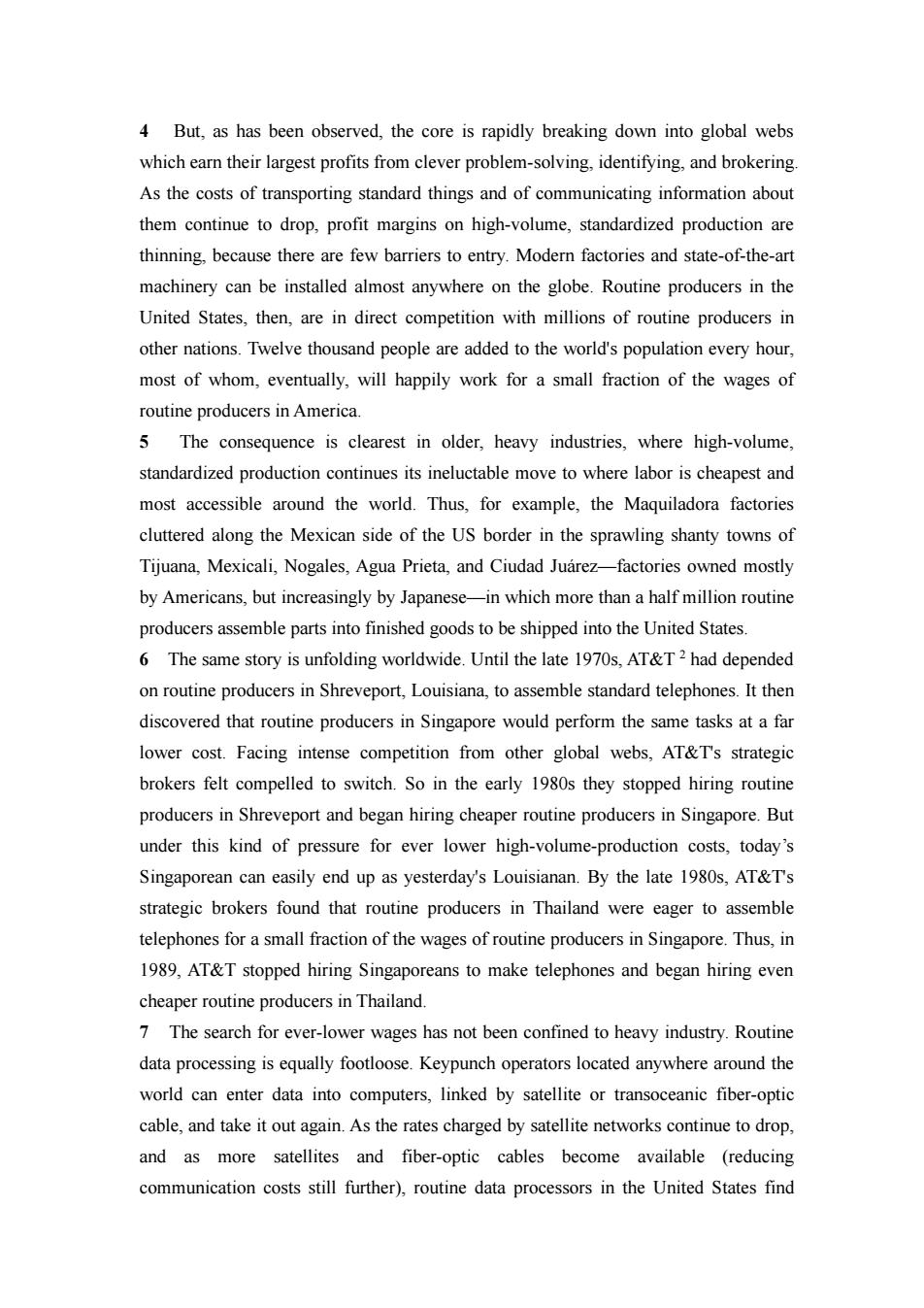正在加载图片...

4 But,as has been observed,the core is rapidly breaking down into global webs which earn their largest profits from clever problem-solving,identifying,and brokering. As the costs of transporting standard things and of communicating information about them continue to drop,profit margins on high-volume,standardized production are thinning,because there are few barriers to entry.Modern factories and state-of-the-art machinery can be installed almost anywhere on the globe.Routine producers in the United States,then,are in direct competition with millions of routine producers in other nations.Twelve thousand people are added to the world's population every hour, most of whom,eventually,will happily work for a small fraction of the wages of routine producers in America. 5 The consequence is clearest in older,heavy industries,where high-volume, standardized production continues its ineluctable move to where labor is cheapest and most accessible around the world.Thus,for example,the Maquiladora factories cluttered along the Mexican side of the US border in the sprawling shanty towns of Tijuana,Mexicali,Nogales,Agua Prieta,and Ciudad Juarez-factories owned mostly by Americans,but increasingly by Japanese-in which more than a half million routine producers assemble parts into finished goods to be shipped into the United States 6 The same story is unfolding worldwide.Until the late 1970s,AT&T2 had depended on routine producers in Shreveport,Louisiana,to assemble standard telephones.It then discovered that routine producers in Singapore would perform the same tasks at a far lower cost.Facing intense competition from other global webs,AT&T's strategic brokers felt compelled to switch.So in the early 1980s they stopped hiring routine producers in Shreveport and began hiring cheaper routine producers in Singapore.But under this kind of pressure for ever lower high-volume-production costs,today's Singaporean can easily end up as yesterday's Louisianan.By the late 1980s,AT&Ts strategic brokers found that routine producers in Thailand were eager to assemble telephones for a small fraction of the wages of routine producers in Singapore.Thus,in 1989,AT&T stopped hiring Singaporeans to make telephones and began hiring even cheaper routine producers in Thailand. 7 The search for ever-lower wages has not been confined to heavy industry.Routine data processing is equally footloose.Keypunch operators located anywhere around the world can enter data into computers,linked by satellite or transoceanic fiber-optic cable,and take it out again.As the rates charged by satellite networks continue to drop, and as more satellites and fiber-optic cables become available (reducing communication costs still further),routine data processors in the United States find4 But, as has been observed, the core is rapidly breaking down into global webs which earn their largest profits from clever problem-solving, identifying, and brokering. As the costs of transporting standard things and of communicating information about them continue to drop, profit margins on high-volume, standardized production are thinning, because there are few barriers to entry. Modern factories and state-of-the-art machinery can be installed almost anywhere on the globe. Routine producers in the United States, then, are in direct competition with millions of routine producers in other nations. Twelve thousand people are added to the world's population every hour, most of whom, eventually, will happily work for a small fraction of the wages of routine producers in America. 5 The consequence is clearest in older, heavy industries, where high-volume, standardized production continues its ineluctable move to where labor is cheapest and most accessible around the world. Thus, for example, the Maquiladora factories cluttered along the Mexican side of the US border in the sprawling shanty towns of Tijuana, Mexicali, Nogales, Agua Prieta, and Ciudad Juárez—factories owned mostly by Americans, but increasingly by Japanese—in which more than a half million routine producers assemble parts into finished goods to be shipped into the United States. 6 The same story is unfolding worldwide. Until the late 1970s, AT&T 2 had depended on routine producers in Shreveport, Louisiana, to assemble standard telephones. It then discovered that routine producers in Singapore would perform the same tasks at a far lower cost. Facing intense competition from other global webs, AT&T's strategic brokers felt compelled to switch. So in the early 1980s they stopped hiring routine producers in Shreveport and began hiring cheaper routine producers in Singapore. But under this kind of pressure for ever lower high-volume-production costs, today’s Singaporean can easily end up as yesterday's Louisianan. By the late 1980s, AT&T's strategic brokers found that routine producers in Thailand were eager to assemble telephones for a small fraction of the wages of routine producers in Singapore. Thus, in 1989, AT&T stopped hiring Singaporeans to make telephones and began hiring even cheaper routine producers in Thailand. 7 The search for ever-lower wages has not been confined to heavy industry. Routine data processing is equally footloose. Keypunch operators located anywhere around the world can enter data into computers, linked by satellite or transoceanic fiber-optic cable, and take it out again. As the rates charged by satellite networks continue to drop, and as more satellites and fiber-optic cables become available (reducing communication costs still further), routine data processors in the United States find